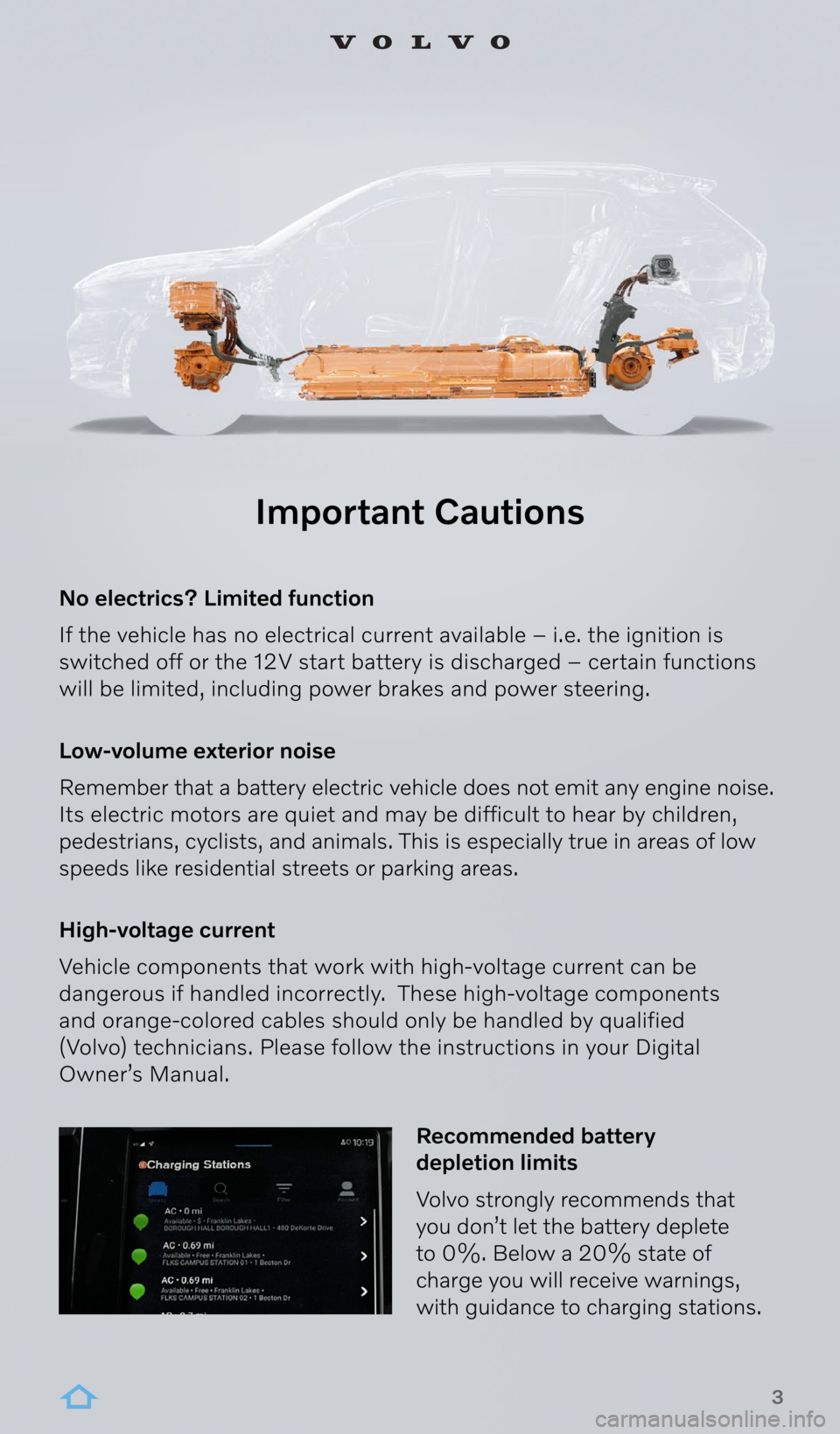battery VOLVO C40 RECHARGE PURE ELECTRIC 2022 Digital Guide
[x] Cancel search | Manufacturer: VOLVO, Model Year: 2022, Model line: C40 RECHARGE PURE ELECTRIC, Model: VOLVO C40 RECHARGE PURE ELECTRIC 2022Pages: 19, PDF Size: 2.28 MB
Page 3 of 19

3
Important Cautions
No electrics? Limited function
If the vehicle has no electrical current available – i.e. the ignition is
switched off or the 12V start battery is discharged – certain functions
will be limited, including power brakes and power steering.
Low-volume exterior noise
Remember that a battery electric vehicle does not emit any engine noise.
Its electric motors are quiet and may be difficult to hear by children,
pedestrians, cyclists, and animals. This is especially true in areas of low
speeds like residential streets or parking areas.
High-voltage current
Vehicle components that work with high-voltage current can be
dangerous if handled incorrectly. These high-voltage components
and orange-colored cables should only be handled by qualified
(Volvo) technicians. Please follow the instructions in your Digital
Owner’s Manual.
Recommended battery
depletion limits
Volvo strongly recommends that
you don’t let the battery deplete
to 0%. Below a 20% state of
charge you will receive warnings,
with guidance to charging stations.
Page 13 of 19

13
Charging Rates and Approximate Times
Volvo’s Pure Electric vehicles (XC40 Recharge and C40 Recharge)
are equipped with 78kWh batteries
Approximate charging times*
• Level 2 – 10% to 80% ≈ 6 hours
• 150 kW DC Fast Charger – 10% to 80% ≈ 40 minutes
* Volvo recommends charging to 90% for everyday use for longer battery life.
For longer trips, charge to 100%.
Ambient temperature extremes (cold and hot), driving styles, routes,
terrain, vehicle speed and vehicle load are some of the conditions
that will affect vehicle range.
Electrification Terms and Their Meanings
• Volt is electrical “pressure” and Amp(ere) is electrical “flow.” The
“garden hose” analogy: Turning up the pressure (volt) moves more
water, and having a larger diameter hose (amp) flows more water.
In this analogy, water is equivalent to power.
• kWh – Kilowatt-Hours: amount of energy stored (comparative to
a tank of gas).
• kW – Kilowatt: amount of electricity needed to “fill up” the battery
via charger (AC or DC).
• 1kW = 1.34 horsepower (e.g., XC40 Recharge’s combined
300 kW = 402 horsepower).
• AC – Alternating Current (typical household outlets, Level 1 or 2,
including some charging stations) converts electric power to direct
current (DC) via an On-board Charger (OBC).
• DC – Direct Current (built-in converter, Level 3 charging stations)
feeds power directly to the car’s battery.
Page 16 of 19

16
The Volvo Cars app
• Lock or unlock
• Door status
• Window Status
• Remote Start (may not be available on all models)
• Pre-Conditioning Recharge vehicles Heating or Cooling
(The app will default to 72°)
• Set climate Timer (For T8 Plug-In Hybrid Drivers)
For T8 Plug-in Hybrid and Pure Electric vehicles only:
• State of charge
• Fuel and battery level
• If you are actively charging, the estimated time
of completion will display under the battery level.
App Icon Functionalities
The Volvo Cars app provides you with useful tools and functions that
enable a convenient and enjoyable Volvo experience.
Page 17 of 19

17
One-Pedal Drive and Regenerative Braking
One Pedal Drive gives seamless control of both acceleration and
deceleration with just the accelerator pedal. When braking, the kinetic
energy that otherwise would have become heat energy is regenerated
into electric energy and fed back to the battery. This saves energy
and helps optimize the car’s range.
Two levels: On and Off.
“ON” is the default setting. Just lifting the accelerator pedal can slow
the car all the way to standstill, not using the brake pedal. It can even
hold the car on steep hills. One-Pedal Drive is recommended in city
driving to help optimize range.
“OFF” means less regeneration when lifting the accelerator, and feels
more like in a combustion engine powered car. This allows full benefit
from the car’s rolling kinetic energy when driving at highway speeds.
Independent of this, the car will always provide brake energy
regeneration when pressing the brake pedal.
www.youtube.com/watch?v=UCBqGZ28Okc